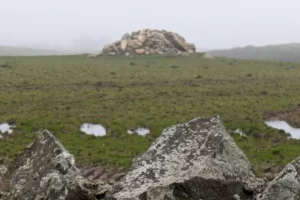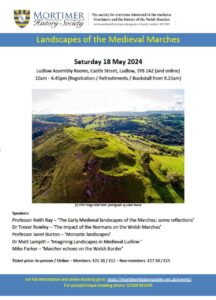See summary below about bone finding archeodog
Elite sniffer dogs help archaeologists unearth 3,000-year-old skeleton Date: 31 August 2023 Source: MSN
Summary: In an innovative approach to archaeology, specially trained dogs in Germany are assisting in the discovery of ancient bones, some dating back 3,000 years. Recently, these elite canines were deployed at a dig site in Neufahrn bei Freising, near Munich, an area known to have been inhabited during the Iron Age and early Celtic period. Additionally, an ancient Roman road intersects the site. The dogs, trained by the Archaeo Dogs initiative founded by Dietmar Kroepel, search the area for bone scents, indicating potential burial sites. Remarkably, after two years of training, these dogs have achieved over a 90% success rate and can detect bones buried as deep as 14 meters. While Kroepel is driven by the excitement of contributing to historical research, the dogs relish the activity of sniffing and running. Read more…
Cookham’s Holy Trinity Church at the centre of archaeological dig Date: 20 Aug 2023 Source: Reading Chronicle
Summary: Archaeologists, alongside students from the University of Reading, are making efforts to unearth the remains of an Anglo-Saxon monastery in Cookham. The local community has actively participated in the excavation next to Cookham’s Holy Trinity Church. This year marks the third of such archaeological dives into the church’s history, having resumed on August 7. The team hopes to uncover more about an Anglo-Saxon settlement, revealing an old cemetery, evidence of a road, housing structures, and cooking equipment. The University has permission to return to the site each summer until 2024, with discoveries already including an industrial and craft zone that supplied nuns with food and facilitated the transport of imported items via the River Thames. Read more…
New find throws light on lives of slaves in ancient Rome’s Pompeii Date: 21 August 2023 Source: NBC News
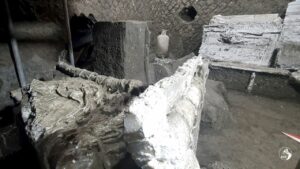

Summary: Archaeologists have unearthed a small bedroom in a Roman villa near Pompeii, believed to have been used by slaves. Located at the Civita Giuliana villa, the room provides insights into the living conditions of slaves during that era. The room contained two beds, one with a mattress, cabinets, and urns with remains of rodents. The discovery highlights the precarious and unsanitary living conditions of society’s lower echelons at the time. Interestingly, no physical restraints like chains or locks were found, suggesting control was maintained through the internal organization of servitude. This villa, located near Pompeii, was buried under volcanic ash from Mount Vesuvius’ eruption in AD 79, preserving many of its structures and inhabitants. Read more…
Archaeologists reveal evidence of British festival held 6,500 years ago Date: 24 August 2023 Source: The Independent
Summary: Archaeologists have uncovered evidence at an ancient festival site near Carlisle that may provide insights into the early origins of British identity. The term “Britain” is believed to be derived from the Celtic word “Pritani,” meaning “the painted ones,” hinting at a prehistoric inclination for body-painting. The recent findings from a 6,500-year-old ceremonial site have revealed over 600 red ochre fragments, the largest collection ever found in Britain. These fragments, along with grinding stones, suggest the production of pigment, possibly for body-painting. The site, located on a former island in the River Eden, was likely a significant gathering spot for fishing and rituals. The discoveries highlight the interconnectedness of Stone Age communities across Britain and suggest a long-standing tradition of body-painting that eventually led to the naming of the island as Britain. Read more…
5,500-year-old menhir discovered in São Brás de Alportel Date: 26th August 2023 Source: Portugal Resident
 Summary: A significant archaeological discovery has been made in São Brás de Alportel with the unearthing of a 5,500-year-old menhir on Monte do Trigo. This stone monument, believed to be from the Neolithic period, is particularly important for the Sotavento region and holds regional significance. The menhir’s shape, material, and dimensions align with other known menhirs from the Neolithic period in Barlavento. The discovery suggests that these early Neolithic communities, which have been understudied in this part of the Algarve, left markers of their presence in the territory. The menhir, which was found partially covered with earth, has endured millennia of human activity and natural elements. Its future remains uncertain, with discussions ongoing about whether to leave it in its current location or move it to a protected site. Read more…
Summary: A significant archaeological discovery has been made in São Brás de Alportel with the unearthing of a 5,500-year-old menhir on Monte do Trigo. This stone monument, believed to be from the Neolithic period, is particularly important for the Sotavento region and holds regional significance. The menhir’s shape, material, and dimensions align with other known menhirs from the Neolithic period in Barlavento. The discovery suggests that these early Neolithic communities, which have been understudied in this part of the Algarve, left markers of their presence in the territory. The menhir, which was found partially covered with earth, has endured millennia of human activity and natural elements. Its future remains uncertain, with discussions ongoing about whether to leave it in its current location or move it to a protected site. Read more…
Study casts doubt on Neanderthal ‘flower burial’ theory Date: 28 Aug 2023 Source: The Guardian
Summary: The 1960 discovery of Shanidar 4, a Neanderthal skeleton surrounded by flower pollen, led to the belief that Neanderthals had intricate burial rituals, including the use of funeral bouquets. This portrayal challenged the brutish image of Neanderthals, suggesting they were compassionate beings. However, recent findings have cast doubt on this interpretation. While the evidence still indicates that Neanderthals had significant funerary practices, the source of the pollen clumps may have been nesting bees rather than flowers. Additionally, the presence of woody fragments and tree pollen suggests that the bodies might have been covered with branches. Despite the debunking of the “flower burial” narrative, the new evidence still points to the possibility of Neanderthals having symbolic rituals and traditions passed down through generations. Read more…
 Huge silver jewellery haul found in Goth cemetery Date: 27 August 2023 Source: MSN
Huge silver jewellery haul found in Goth cemetery Date: 27 August 2023 Source: MSN
Summary: In Poland, a significant Gothic cemetery has been discovered, revealing silver jewelry from the fourth century. The discovery was made by Olaf Popkiewicz, an archaeology video content creator on YouTube, near the Wda River. The site, located within the Wda landscape park, yielded two silver necklaces, silver fibulae (brooches), and beads from another necklace. Park archaeologists, after being alerted, unearthed 50 Gothic graves over an area of 2,700 square feet, finding grave goods like pottery, brooches, amber beads, and jewelry with snake motifs. The site is believed to be just a fraction of a larger burial area spanning 2.5 acres. The unearthed remains suggest the Goths practiced both inhumation and cremation, aligning with common practices of Germanic tribes. Read more…
Stone age Dartmoor viewpoint uncovered by archaeologists Date: 30 Aug 2023 Source: The Guardian
 Summary: Archaeologists and volunteers have identified a Stone Age viewpoint on Dartmoor, Devon, where ancient individuals likely observed the landscape for prey. Over 80 flint pieces were retrieved from the location, currently farmland near Lustleigh village. The experts surmise that around 8,000 years ago, ancient people crafted tools from flint cobbles at this site while monitoring the surroundings for animals like red deer, boar, and possibly reindeer. Emma Stockley, leading the project, highlighted the site’s panoramic views of nearby valleys and the high moor, suggesting its potential as a lookout point. The majority of the flints found were by-products of tool-making, indicating a human presence since flint is not native to Dartmoor. Read more…
Summary: Archaeologists and volunteers have identified a Stone Age viewpoint on Dartmoor, Devon, where ancient individuals likely observed the landscape for prey. Over 80 flint pieces were retrieved from the location, currently farmland near Lustleigh village. The experts surmise that around 8,000 years ago, ancient people crafted tools from flint cobbles at this site while monitoring the surroundings for animals like red deer, boar, and possibly reindeer. Emma Stockley, leading the project, highlighted the site’s panoramic views of nearby valleys and the high moor, suggesting its potential as a lookout point. The majority of the flints found were by-products of tool-making, indicating a human presence since flint is not native to Dartmoor. Read more…
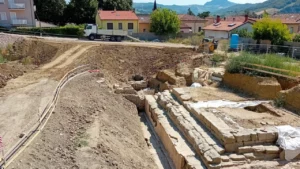 ‘Extremely rare’ Roman temple discovered on supermarket building site Date: 30 August 2023 Source: CNN
‘Extremely rare’ Roman temple discovered on supermarket building site Date: 30 August 2023 Source: CNN
Summary: In the small town of Sarsina, Italy, construction workers stumbled upon an ancient Roman temple, or ‘capitolium’, from the first century BC while preparing for a new development. The site revealed a structure made of horizontal sandstone blocks and marble slabs, believed to be the podium for the temple. The excavation has so far unveiled three rooms, possibly dedicated to the gods Jupiter, Juno, and Minerva. Romina Pirraglia, the lead archaeologist, mentioned the discovery of an older layer of ruins from the 4th century BC, hinting at the temple’s vast size. The temple’s exceptional preservation is attributed to Sarsina’s remote location, which protected it from invasions and plunders. Local authorities are now revising their building plans to preserve this significant find. Read more…
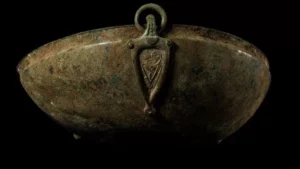 ‘Old bucket’ turns out to be ‘excessively rare’ Anglo-Saxon bowl Date: 2 September 2023 Source: BBC News
‘Old bucket’ turns out to be ‘excessively rare’ Anglo-Saxon bowl Date: 2 September 2023 Source: BBC News
Summary: Chris Ulliott, a metal detectorist, was taken by surprise when what he initially believed to be a “rusty old bucket” turned out to be a rare Anglo-Saxon bowl. Ulliott discovered the artifact during an organized dig in Ryedale, North Yorkshire. The bowl, described as “almost complete,” is expected to be auctioned for an estimated £20,000 to £30,000. The relic is an “excessively rare, almost complete copper-alloy hanging bowl.” Ulliott and the landowner plan to split the auction profits, setting a reserve of £16,200. Brett Hammond, the managing director of Timeline Auctions, emphasized the rarity of the find, especially given that copper alloys typically don’t withstand the test of time. Ulliott, who began metal detecting in 2020, plans to use his share of the proceeds to purchase a new camera and treat his family. Read more…
Pottery and animal bones from 1200s found at dig site of new swimming pool Date: 2 September 2023 Source: Coventry Telegraph
Summary: During the groundwork for a new multi-million-pound swimming facility at Abbey Fields in Kenilworth, archaeologists unearthed pottery, animal bones, ceramics, and roof tiles believed to be from the 13th century. These artifacts were found alongside previously unrecorded remains of at least five buildings associated with Kenilworth Abbey. The function of these buildings remains uncertain, but some might have served as kitchens or guesthouses during the 1200s. A significant amount of metalworking debris suggests the presence of a nearby blacksmith’s workshop. Due to these extensive discoveries, Warwick District Council has revised the construction plans to ensure the protection of the medieval remains. The new design will elevate the swimming pool complex over the ancient site. Read more…
 The bronze age Spice Girl in reopened £7million Scottish museum Date: 2 September 2023 Source: HeraldScotland
The bronze age Spice Girl in reopened £7million Scottish museum Date: 2 September 2023 Source: HeraldScotland
Summary: A Bronze Age woman, whose reconstructed face bears a resemblance to Spice Girl Victoria Beckham, is set to be a highlight at the newly reopened Kilmartin Museum in Argyll. The hyper-realistic silicon model was created by Swedish forensic artist Oscar D Nilsson using the fragmented remains of her skull. The woman, who lived 4,000 years ago, was discovered in Kilmartin Glen, an area rich in prehistoric monuments. The museum, which underwent a £7 million reconstruction, will showcase its recently recognized Nationally Significant Collection of over 20,000 prehistoric artifacts. The Bronze Age woman’s skeleton was discovered in Upper Largie in 1996, and she is believed to have lived during a time when Kilmartin Glen was a significant ceremonial region. Read more…





